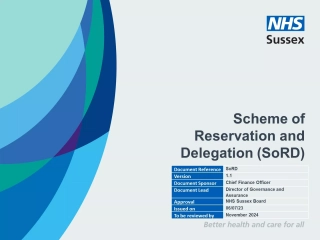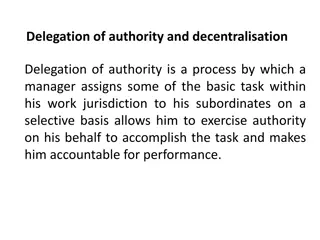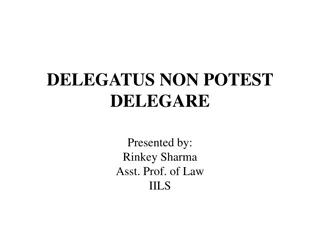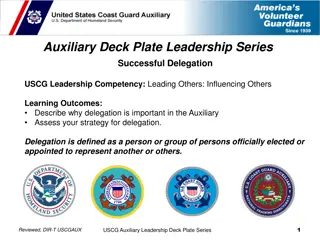
Effective Team Performance Through Delegation and Interdependence
Explore the importance of delegation in teams and the impact of social interdependence theory on team roles for enhancing performance. Discover why tasks are delegated, the dynamics of positive and negative interdependence, and how shared beliefs and values contribute to successful team collaboration.
Download Presentation

Please find below an Image/Link to download the presentation.
The content on the website is provided AS IS for your information and personal use only. It may not be sold, licensed, or shared on other websites without obtaining consent from the author. If you encounter any issues during the download, it is possible that the publisher has removed the file from their server.
You are allowed to download the files provided on this website for personal or commercial use, subject to the condition that they are used lawfully. All files are the property of their respective owners.
The content on the website is provided AS IS for your information and personal use only. It may not be sold, licensed, or shared on other websites without obtaining consent from the author.
E N D
Presentation Transcript
Delegation in teams and team roles Contributing to effective team performance
Objectives Understand why delegation in teams is important Have a look at theories that encourage us to think about team roles to understand how they contribute to effective team performance
Group work - What is delegated to teams? Think about your own organisation and what is delegated to teams: Why are some tasks delegated to teams? What can teams achieve together that they cannot achieve individually? Why is delegation to teams important?
Why are some tasks delegated to teams? Tasks can be delegated to teams based on the view that what needs to be achieved cannot be done by one person alone this can be viewed as interdependence which is mutual dependence between members to achieve a specific goal or task. There are various theories on interdependence, e.g. social interdependence theory focuses on mutual dependence between group members to reach a common goal (Deutsch, 1958, 2002). This interdependence between group members is motivated by the need to achieve a common goal.
Social interdependence theory (Deutsch, 1958, 2002) Positive interdependence reflects cooperative relationships and effective communication, with open discussion where group members are willing to accept each other s ideas. This reflects members mutual recognition of everyone s contribution towards the group, and mutual trust is high. The coordination of effort, division of labour and sharing of resources is unproblematic.
Social interdependence theory (Deutsch, 1958, 2002) There is a shared sense of beliefs and values which includes a willingness to enhance each other s power. Any conflicting interests are considered to be a mutual problem to be resolved through this interdependence and shared effort.
Negative interdependence is the converse of features displayed in positive interdependence. For instance, negative interdependence reflects competitive relationships (as opposed to cooperative relationships) where the solution to conflicting interests can only be imposed by one side or another. Group members may obstruct each other s success via coercion, threat and deceptive communication in a bid to enhance their own power to the detriment of others.
Negligible interdependence exists when individuals see no relationship between their goals and the goals of others, providing no incentive to work together. It is acknowledged that these three forms of interdependence may operate within the same team at different times because cooperative and competitive interests may be intertwined, particularly during the resolution of conflict. Social care and health leaders and managers have a role to play in fostering positive interdependence in encouraging team members to understand why they need each other to produce positive service outcomes.
What can teams achieve together that they cannot achieve individually? An inclusive approach to individuals and carers needs Covering hours of work in a 24 hour service Managing risk of individuals and staff members Sharing information with each other Sharing skills and supporting each other to develop skills Sharing practical resources Supporting each other on an emotional basis Learning with and from each other Working together to ensure that all of the requirements of a service are met Managing changes in legislation and practices
Why is delegation to teams important? Ensure that goals and tasks are achieved Provide good quality services Support individuals to fulfil their roles Manage risk and responsibility Safeguard individuals and staff through collective responsibility
Lets put a theory on team work to the test! Tuckman (1965) Forming, Storming, Norming, Performing Forming The team leader may be allocated a task but they and their team members are unclear about the direction of travel Unclear roles and responsibilities Lots of questions Disregard for processes as anxiety takes hold Relationships are being tested
Storming Unclear and changing decisions There may be power struggles as the team leader and team members seek to establish their position The shared goal may become clearer but there are still many unanswered questions The team leader s role is critical here they need to ensure that team members remain task and goal orientated
Norming The team leader has become a respected and effective facilitator having developed some form of consensus Individuals are clear about their roles and responsibilities Team members make and own big decisions and potential consequences Individuals may be responsible for implementing smaller decisions There is commitment and unity - the team might even have some fun! Shared understanding about working togther
Performing There is clarity of purpose to achieve a shared goal The team leader has enabled team members to become more independent they can take delegated tasks forward without reliance on the team leader; support may still continue in relation to professional development and personal issues Disagreements are resolved positively There is positive interdependence (Deutsch, 1958, 2002) between team members
There is a fifth stage called adjourning when a team disbands, but this is not always the case
Be aware of Belbin (2010) 9 team role contributions Roles and descriptions Team role contribution Allowable weaknesses 1. Plant: Creative, imaginative, unorthodox. Solves difficult problems. Ignores details. Too preoccupied to communicate effectively. 2. Resource investigator: Extrovert, enthusiastic, communicative. Explores opportunities. Develops contacts. 3. Co-ordinator: Mature, confident, a good chairperson. Clarifies goals, promotes decision- making, delegates well. Overoptimistic. Loses interest once initial enthusiasm has passed. Can be seen as manipulative. Delegates personal work. 4. Shaper: Challenging, dynamic, thrives on pressure. Has the drive and courage to overcome obstacles. Can provoke others. Hurts people s feelings.
Roles and descriptions Team role contribution Allowable weaknesses 5. Monitor Evaluator: Sober, strategic, discerning. Sees all options. Judges accurately. 6. Team worker: Co-operative, mild, perceptive, diplomatic. Listens, builds, averts friction, calms the waters. Lacks drive and ability to inspire others. Overly critical. Indecisive in crunch situations. Can be easily influenced. 7. Implementer: Disciplined, reliable, conservative, efficient. Turns ideas into practical actions. Somewhat inflexible. Slow to respond to new possibilities. 8. Completer Finisher: Painstaking, conscientious, anxious. Searches out errors and omissions. Delivers on time. Inclined to worry unduly. Reluctant to delegate. Can be a nit-picker.
Roles and descriptions Team role contribution Allowable weaknesses 9. Specialist: Single-minded, self- starting, dedicated. Provides knowledge and skills in rare supply. Contributes on only a narrow front. Dwells on technicalities. Overlooks the big picture .
References Belbin (2010) Team roles at work. [Online].Available at: https://www.dawsonera.com/ (Accessed: 1 February 2019). Belbin Associates (2015) Belbin team roles. Available at: http://www.belbin.com/about/belbin-team-roles/ (Accessed: 1 February 2019). Deutsch, M. (1958) Trust and suspicion , The Journal of Conflict Resolution, (2) 4, pp. 265-280. Proquest Psychology Journals [Online]. Available at: http://onlinelibrary.wiley.com/ (Accessed: 1 February 2019). Deutsch, M. (2002) Social psychology s contribution to the study of conflict resolution , Negotiation Journal, 18 (4), pp. 307-320. Wiley Online Library [Online]. Available at: http://onlinelibrary.wiley.com/ (Accessed: 1 February 2019). Emery, E., Millheiser, A., Garcia, C., Marquine, M. and Golden, R. (2011) Community long-term teams: assessing team fitness , Clinical Gerontologist, 34, pp. 355 366. EBSCOhost CINAHL Plus [Online]. Available at: https://health.ebsco.com/products/cinahl-plus-with-full-text (Accessed: 1 February 2019).




















